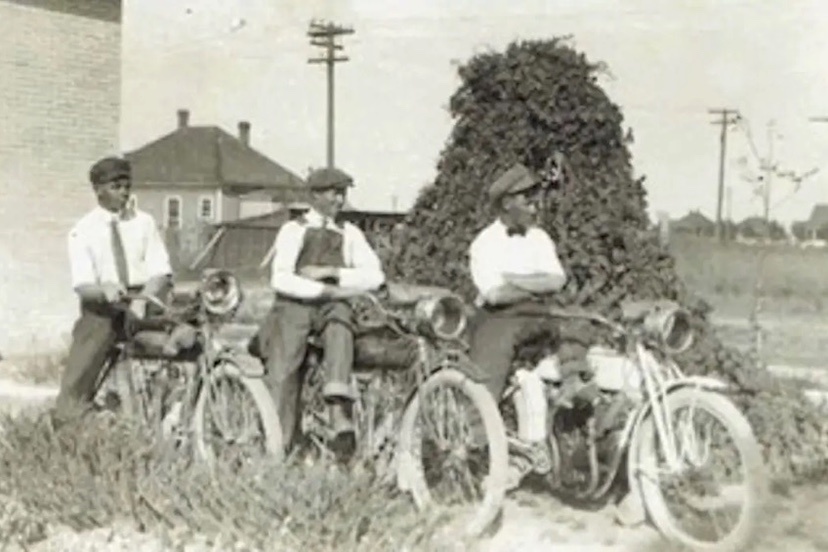Photo: Ray E. Rieke (my grandfather) at left, and his brother Henry Rieke at right, with Lehman Lykou, my grandfather’s traveling companion to San Francisco. After a few days at the World’s Fair, they traveled through California’s Central Valley to San Diego, dipping down to Tijuana. Then my grandfather and I assume his motorcycle caught a train back to Colorado.
My grandfather was born in a sod house on the Colorado prairie in 1890. A generation before it had been the domain of buffalo and the Cheyenne, Sioux and other tribes that feasted on them.
He was taken while still very young to the nearest town, Sterling. Cresting a ridge, he glimpsed the South Platte River Valley for the first time. What did he see, his elders asked? Cows, he guessed, and lots of them. He had no basis for imagining so many trees.
Grandpa somehow found his way to a two-year degree from Colorado A&M, now known as Colorado State University. Then he sought adventure. With a buddy, he set out from Fort Collins in 1915 for the World’s Fair in San Francisco. They could have taken a train, I suppose, but they rode motorcycles.
Travel by car, any car, beyond cities was an adventure then. His memoir from many years later talks about dusty, difficult travel across Wyoming, Utah and Nevada on little more than dirt paths. At one point, the so-called highway was so inadequate they rode their motorcycles on the railroad tracks. It took spunk to travel beyond cities in these new gas-powered vehicles.
I wonder whether my grandfather, if he were around today and living in the farm-ranch country of Colorado, would own an electric pickup. People in the early 20th century traveled by coal-powered trains or were pulled by animals. The transition to internal-combustion engines did not happen overnight. It took time to create the infrastructure.
Colorado today has more than 100,000 registered electric vehicles but hopes to have nearly a million by 2030. This will be necessary for Colorado to meets its decarbonization goals. It will also help us reduce the nasty ozone-soaked air quality that can make breathing more difficult. San Francisco has already proven that higher penetration of EVs can improve air quality. We need the same success along the Front Range.
We’re moving fast in this transition. EVs — including plug-in hybrids – constituted 16% of all sales in Colorado during 2023, according to the Alliance for Automotive Innovation. That’s nearly four times the penetration of four years before. A state sales tax credit that went into effect in July 2023 has put wind into the sales. Tellingly, Tesla had the top-selling models for both passenger cars and light trucks. But in a couple years we should start seeing more diversified and lower cost models from the major manufacturers.
Nationally, you can find many stories about stumbles of the EV market. The most optimistic cite the more confident sales of hybrids, as consumers remain leery of going all electric.
Charging infrastructure remains an issue. I hear anecdotally of concerns about maintenance. Also, not every corner has a charging station. Even the fast-chargers take longer than gassing up. Traveling takes some forethought, more deliberate timing of lunch and other breaks.
It’s getting easier all the time, though. The Polis administration recently announced $22 million in grants that will yield 290 new fast-charger ports at 46 different sites from Holyoke to Dolores, from Burlington to Silverton, in both our small towns and big cities. As of February, direct-current fast chargers were located within 30 miles of 78% of the state’s geographic areas.
I’m sure that my granddad had to do a lot more thinking.
EVs are not the answer everywhere for all purposes. I hear complaints from Wray to Alamosa about the inadequacy of electric trucks to pull heavy loads, whether of hay or of recreational vehicles. CleanTechnica tells of an experiment. Four electrified pickups — the Ford F-150 Lightning, Cybertruck, Rivian R1T, and the Silverado EV each towed a 4,000-pound car between Denver and Grand Junction. Three lost much range. Only the Silverado EV pulled its weight well.
But EVs have this distinct advantage, one I first heard articulated by the late Randy Udall 15 years ago: Electric motors can convert energy into motion six times more efficiently than internal combustion engines.
Hiccups will almost certainly occur on this journey. And some of our existing pickups and cars will be around for decades. The turnover will take time.
If the comparison is not exact, I think about the transition that occurred during my Grandpa Rieke’s time. In 1924, the only way to traverse the Continental Divide in Colorado during winter was by train or on foot. No roads were plowed until 1930 when Berthoud Pass for the first time became an all-season crossing.
Compared to that transition, this shift in transportation will be very easy, and very quick.
Allen Best publishes the e-journal Big Pivots, which chronicles the energy transition in Colorado and beyond.

